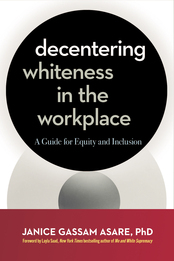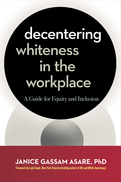1
the
formation
of
whiteness
Before we dive into the ways that whiteness is centered within the workplace, it’s important to first define what whiteness is and how it was created. When I speak about the formation of whiteness, I have to mention that I am speaking primarily from a United States perspective. Although this discussion will be US specific, it is also helpful for those who employ Americans and those with US-based work locations. In the upcoming chapters, when we delve into the ways that whiteness is centered in the workplace, this discussion expands beyond the US and reflects many countries around the world.
I have to admit: I’ve never been a history person. When I was in high school, history—or social studies, as it was called back then—was my least favorite subject. As I’ve gotten older and expanded my knowledge about workplace equity, I realize how important history is in any conversation about justice and liberation. In her book Freedom Is a Constant Struggle, Angela Davis talks about the importance of developing a shared language to talk about racism. Davis writes, “The call for public conversations on race and racism is also a call to develop a vocabulary that permits us to have insightful conversations. If we attempt to use historically obsolete vocabularies, our consciousness of racism will remain shallow.”1 This chapter is my attempt for us to develop a shared understanding of whiteness and how it was constructed.
In conversations with my friend Joquina Reed, a decolonial educator and workplace consultant, we’ve talked about white supremacy and how it differs from whiteness. Since white-centering is a tenet of white supremacy culture, it is vital to have a full understanding of whiteness and how it was constructed and developed in the US. When I asked Joquina to elaborate on this, she explained, “It is essential to distinguish that before white people could see themselves as morally superior, they had to see themselves as white first. That apparatus had to be standardized before the manifestation of its premise could occur. That is to say, first came whiteness, and supremacy shortly followed.”
The Construction of Whiteness
One phrase that we often hear is that race is a social construct. The racial categories we assign to others are not based on genetics or biology. Theodore W. Allen, an American writer known for his work around white racial identity, argues in his book The Invention of the White Race that the white race historically was formed as “an all-class association of European-Americans held together by ‘racial’ privileges conferred on laboring-class European-Americans relative to African-Americans.”2 As Allen states in his seminal work, “When the first Africans arrived in Virginia in 1619, there were no ‘white’ people there; nor, according to the colonial records, would there be for another sixty years.”
When trying to conceptualize the American idea of whiteness, Nell Irvin Painter, who wrote the book The History of White People, states that at the core of our understanding of whiteness is an association between whiteness and freedom. When we think of enslavement, we associate it with racial difference.3 There wasn’t an interest in “white identity” until European-Americans realized, in the seventeenth century, that there were privileges attached to it. In the US, Painter explains, our first notions of whiteness included all male Europeans and their free male children.4 In 1790, the US Congress stated that only white people could be naturalized as citizens.5 Painter also brings up the very important and interesting fact that racial oppression is not based or dependent on a person’s phenotype (physical characteristics and features), pointing out that the intellectual Gustave de Beaumont considered “Indians and Negroes the very extreme of human wretchedness” but thought of the poor Irish as the worst of both worlds because they lacked the freedom of the American Indian while also lacking security like the American slave.6
Painter indicates that as the conception of whiteness began to evolve in the US, the racial hierarchy morphed into Anglo-Saxons being at the top and the Irish right under them. At some point, the Irish would be considered Nordic and were elevated into the upper hierarchy of the US. Slavic immigrants from the Austro-Hungarian Empire, Jews from Russia and Poland, and Italian immigrants had to be judged within the racial hierarchy.7 Karen Brodkin addresses how the construct of whiteness evolved for Jews in particular in her book How Jews Became White Folks, in which she asks: Are Jews a race? Brodkin argues that based on ethnoracial assignment, they are, but notes that they did not assign themselves into a particular category but instead were assigned by American society.8
Irish Migration
To understand how white racial identity was formed, we must dive further into the history of Irish immigration to the US. Many of the same people who experienced oppression in Ireland because of their Catholicism were able to absorb the white racial identity in the US, and in doing so became racial oppressors. Noel Ignatiev analyzed how the Irish became white in his book of that name.9 In the eighteenth century, Irish Catholics were the oppressed group within Ireland and often saw themselves as a “race” rather than a nation. They were prohibited from opening or teaching schools, attending universities, voting or serving in Parliament, and living in certain places. The Irish began immigrating to the United States in large groups in the 1800s, taking up residence in the same neighborhoods and holding many of the same jobs as Black people. Interestingly, a term sometimes used to describe Black people in that time was the “smoked Irish.”10
According to Ignatiev and others, upon the arrival of the Irish into the United States, intergroup conflict with Black people emerged. Scholars have suggested that the main reason was labor competition. Chattel slavery in the US was “abolished” in 1863, and the Irish and formerly enslaved Africans were now competing for jobs. Ignatiev notes that “white workers organized to defend their caste status, even while striving to improve their condition as workers. They prohibited free Afro-Americans from competing with them for jobs, in effect curtailing their right to choose among masters.”11 The Irish soon learned that in order to enjoy the privileges that they hoped to gain when they arrived in the US, they had to assume the white label and support the subjugation of Black people.
An important point to note, which several researchers, historians, and writers have highlighted, is that two of the primary means through which groups were put into racial categories were the type of labor they engaged in and the neighborhoods they lived in. White as a racial construct cannot exist without “white man’s work.” White man’s work can be conceptualized as work that Blacks were excluded from participating in. Anyone who engaged in white man’s work could be thought of as white. Subsequently, no Black person was able to work in the same jobs as the Irish. Whiteness is often thought of in terms of the dichotomy between whiteness and blackness—that is, blackness as the antithesis of whiteness. For Europeans arriving in America, then, the way to assume whiteness and rise within the racial hierarchy was to distance themselves from blackness. Anti-blackness was learned and adopted quickly.12
THE EVOLUTION OF WHITENESS
A few months ago, I was scrolling through TikTok, as I’ve found myself doing more and more as of late, and I came across a video from a creator I follow named @meccavellii. She was discussing antisemitism and what’s been going on with Kanye West. She said something about white supremacy that I will quote directly: “The way that white supremacy works, it has to absorb groups to keep advancing and stay in power.”13 I thought a lot about what she said and as I started reading more into the conception of whiteness in the US, her words rang completely true. Whiteness needs and feeds off other groups and communities in order to regenerate and continue to survive and thrive. Part of the reason may be because demographers have predicted that by around the year 2045, the US will be majority non-white.14 I know this is a thought that worries and frightens many white people. So what are the ways to address this demographic shift? Perhaps the amalgamation of non-white groups to absorb or assume whiteness in order for the race to survive. As we’ve seen with Irish and Jewish immigrants, whiteness has evolved so much over the years, and we can see changes in who we perceive to be white.
Racialized Groups
At its founding, American society was triracial, including red, black, and white races. In addition to the black/white contrast, there was the red/ white contrast. Native Americans, who were considered “red,” were stereotyped as being savages who failed to adhere to European customs and norms.15 In my second book, The Pink Elephant, I focused on a few historical events and the important role that they played in othering specific groups. One event I explored was the Trail of Tears, the forced migration of Native American tribes by the US government. Native Americans were depicted in similar dehumanizing ways as Africans during that time period. Redness became seen as “savage, threatening and unassimilable,” Brodkin explains.
As employees from different parts of Europe and Asia began to immigrate to the US for factory work, the racial stratifications classified Asian and European immigrants into similar castes as Black and Native American workers. In the late nineteenth century, as Mexican immigration intensified, working-class Mexicans too experienced racial stigma-tization.16 Around the same time, and another event I explore in The Pink Elephant, was the passage of the pivotal 1882 Chinese Exclusion Act, the first race-based immigration legislation in the US.17 The act was one outcome of the anti-Chinese movement where racial violence was enacted against Chinese people.
In 1965, with the influx of immigrants as a result of the new immigration laws, the Federal Interagency Committee on Education was formed to help develop a racial and ethnic classification system. One result of that committee was the creation of the four racial categories we still use today: American Indian/Alaska Native, Asian/Pacific Islander, Black, and white. A fifth category was later developed for people of “Hispanic” background. The problem with these categories is that they lump unique groups together as one. Based on these racial categories, for example, an individual from the Middle East would be classified as white. Changes are now being made to redefine racial and ethnic categories for greater accuracy. Two examples are the various iterations of the Hispanic/ Latino classification and the newly established Middle Eastern North African ethnic (MENA) category.
As Painter notes, American slavery and Black people were central in creating a white identity. Even though our understanding of race continues to expand, the white/black binary prevails. This is why the primary focus of this book is on whiteness and the ways that it is centered. In the upcoming chapters, we’ll also explore blackness and the global nature of anti-blackness. Within the US, the conceptions of whiteness differ from other parts of the world. There is still a lack of consensus about what whiteness is and means and who is truly white and non-white. Race is partially a social construction. As society changes, so do our conceptions of race.
NOTE The US Census Bureau identifies the white race as “A person having origins in any of the original peoples of Europe, the Middle East, or North Africa.”18 When I speak of whiteness in this book, I will use a modified version of the US Census information. Since MENA is becoming its own racial, ethnic, and cultural category, which I think is vastly different from white and European culture, when I refer to white people or the white race in this book, I am referring to people who originated from Europe.














